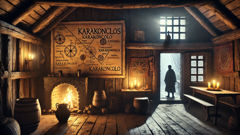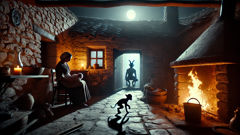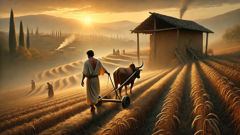Introduction
In the high, wind-cut villages that ring the western edge of Anatolia and spread like a mesh into the Balkan hills, the twelve nights after Christmas keep a different calendar than the rest of the year. Farmers who have just stacked wood and salted barns lean on their doors and tell one another, low-voiced and half-laughing, about the small shape that will try to step into their houses once the church bells fall silent. They call it by many names across dialect and border: karakoncolos, karakondžula, karakuş, karakoncolak — a word that flattens into a single malicious presence in the dark. It is not an equal-opportunity spirit; it knows which homes hold new babies, which hearths shelter grief, which barns have an unlocked window. It does not come for the monks who keep vigil, nor the old women who scatter salt and cloves across thresholds; it comes for the careless, the superstitious, the households that have forgotten the old rules.
This tale is a durable one, stitched from the wool of many nights when candles guttered and the rain sounded like someone dragging a sack of bones. I offer it with care but without apology: the Karakoncolos is at once a mischief-maker and a test. It is a window into how communities held themselves together by ritual and story, and how fear could be a kind of practical wisdom. Listen, then, to how it came to be feared, to how the twelve days were measured in footsteps and flung coal, and to the family who learned that sometimes the smallest creatures carry the centuries-long memory of right and wrong.
Origins, Names, and the Twelve Nights
The Karakoncolos moves across maps and tongues like a misread letter, arriving in village speech with subtle shifts. In Ottoman registers it might be couched under the broad category of 'evil spirits'; in Balkan songs it becomes the karakondžula, a shadow with a hooked voice. The first tales jewel in the mouths of shepherds and wet-nurses, who translated danger into a personality: small, often male, malevolent and liminal, not quite a demon and not quite a household pest. People told of a creature that appears when the old year slips under the new and the boundaries between days thin: twelve nights, twelve doors, twelve chances for the Karakoncolos to test a family's guard. These nights, called in many places the 'Twelve Days'—from Christmas until Epiphany—were liminal by weather and by fate. Snow sat like a second roof on the valley; animals were stabled; the world outside was closed and receptive to whatever crept through cracks in time.

The stories diverge in detail but agree on essentials. The Karakoncolos prefers the dark and the hush. It is quick as rats, but not silent: often it whistles or knocks, taps the eaves, or shakes a loose shutter at three in the morning. It can mimic voices — a child's whimper, a wife's laugh — but with a grain of wrongness in the timbre that reveals its trick. Folklorists who collected testimonies in the nineteenth and early twentieth centuries wrote of flour overturned on kitchen floors, milking stools upended, and children's toys misplaced in impossible places. Where a Christian household saw a test of faith, a Muslim household might see a djinn's cousin, a pagan-worn superstition still resilient beneath prayers. The Karakoncolos did not respect the border of creed; it respected openings, neglect, and the scent of fear. It was drawn to households that had unlocked their doors in arrogance or left the baby to sleep with a single blanket. In older strata of the tale, the creature could be bargained with: a small offering of bread, a pat of butter, or a bit of salted meat might keep it moving. In later tellings, after recollections filled in the creature's appetite for spite, such bargains seemed less possible: salt and frankincense and careful vigilance were the only currency.
Names recorded across villages read like a geography of suspicion. In Serbian carols it is karakondžula; in Bulgarian it becomes karakondjul; in Turkish provinces it appears as karakoncolos or karakoncolu, a term whose first syllable, kara, means black, and whose rest collapses into forms of mischief. Old women carry a lexicon of avoidance: say the creature's name and it may hear; call it by another name and you might trick it for a night. Even the timing of its visits varies by valley. Some say the first night when church lights are put out is the worst. Others insist on the twelfth night as the peak when the Karakoncolos is both most daring and most tired — an exhausted malice searching for careless warmth.
Material culture folded into the myth as a set of household practices. Farmers hung bells by their gates, not to ward off wolves but to ring when a small thing tried the latch. Families left a small bowl of gruel turned away from the door, not as hospitality but as a trick: the Karakoncolos, greedy and gullible, would lap at it and be delayed until dawn, when light spent whatever boldness it carried. Some houses kept fire-burning spells: embers were never allowed to die during the twelve days, and any corpse of ash was swiftly buried beneath salt. People braided garlic into lintels and drew crosses across thresholds. In coastal towns these practices mixed with Christian customs of blessing the house; inland, they braided with older pre-Christian rites that asked the household spirits to oppose the newcomer.
The Karakoncolos also carried the weight of warning. It showed how communities transferred anxieties about childbirth, poverty, and the winter season into a single shape. A family that lost a child in the dark told the story in which the creature had been seen knocking on the window at night, its long hands wanting warmth. The moral was subtle: waste not, lock your doors, share what you can in the day so that hunger does not creep as malice at night. Thus the creature's story served both as entertainment around the stove and as practical instruction for safeguarding life when the weather tested human will and the world outside closed its teeth.
And yet, for all its nastiness, the Karakoncolos became, in certain songs and whispered verses, a mirror. The way a household responded—ritual, superstition, prayer, or kindness—announced what that household valued. Households that welcomed strangers sent out bread and broth; those that kept out any stray became the creature's preferred haunt. Over centuries, belts of folklore stitched this caution into the communal psyche. The Karakoncolos was a thief and a question: what will you protect, and at what cost? The tale that follows is one such answer, told through the particular time a boy named İlyas and a widow called Mara met the creature on a night when snow made sound forget itself and the valley held its breath.
Encounters, Rituals, and a Night of Reckoning
People in the high villages told their Karakoncolos stories like weather reports: precise, practical, and full of small warnings. The story of İlyas and Mara became, in weeks and seasons after the event, a narrative turned over and softened by many tongues, but its skeleton remained: a night of testing, a misstep, and a lesson learned too late for laughter.

İlyas was not yet a man when the Karakoncolos took notice. He had been born during a bitter winter, and the midwife had said he cried like someone who remembered a different house. He was the only son of a widow, Mara, who had kept the household together with stubborn hands and the odd day of labor for neighbors. Their stone house sat at the village edge, where the path climbed into scrub and then forest. To their neighbors they were ordinary. To the creature, they were a slender prize: a house with a single watchman and a pantry whose smell was a public secret.
The winter of the story had been the sort that makes men measure time by the thickness of ice. The twelve days wedged between Christmas and Epiphany were streaked with storms; villagers kept candlelight low to protect against the wind and worry. One night — the fifth, some say, the sixth, the memory of the exact count becoming part of the telling — Mara stayed up longer than usual because an old cow had calved. The labor took hours. She wrapped the newborn in flax and left it under a blanket by the stove while she dressed the animal. In that hour a small shadow slipped close to the eaves. It had watched the light in their window like a creature reading a map. It could mimic a child's call and imitate a voice that had gone to gather fire. It knew when a door was left ajar.
The Karakoncolos arrived with a sound like a pebble rolled onto a wooden floor. It whistled at the latch and knocked thrice, softly, counting the family's courage. When Mara did not answer — she was binding the cow with bundles of reed — the creature slipped in the moment the door warmed from her back. It moved small and quick, and in the hours that followed the house turned into a theater of mischief. A ladle went missing, only to be found balanced in the chimney. Flour had been poured on the threshold to mark a circle of shame. The creature sat on the window ledge and mimicked the crying of a child, and though its voice held all the wrong harmonics, the ache that came with it was real enough to thin Mara's blood.
It is important to note that encounters with the Karakoncolos often hinge on the household's existing troubles. Mara's husband had been dead two winters by then, and her nights were threaded with the kind of fatigue that forgets to lock bolts. The creature found a gap and exploited it. But when it reached for the newborn, when it curled its long fingers around the blanket and tried to lift the child's warmth toward the open hearth, the household's small defenses woke. İlyas, who had been half-asleep, smelled the wrongness in the air — an acidity like metal left in the sun — and sat up. He did not know the old words to call for help; he only knew that a thing that should not be cold smelled like smoke in his room.
He stepped between the creature and the baby. In the story as told afterward, his manner was heroic and foolish in equal measure: he wrapped a shawl around his arm, the part his mother had been mending, and lunged. The creature hissed and dropped the blanket. It was faster than any boy but clumsier in its fury. It stole silver spoons and hid them beneath the floor, it tied a knot in the cow's tail so it would not give milk in the morning, it rattled the beams until nails sang. Villagers who heard the tale afterward said that the creature's laughter was like ice cracking in a river: at once small and inexorable.
What saved the household that night was not only İlyas's courage but the trickery he learned from the old women at market. They had told him that the Karakoncolos can be delayed by contact with what is ordinary and useful: salt, iron, the odor of sharp garlic. Mara had, earlier that week, hung a small iron nail by the lintel because the cow had been restless. When the creature flung itself at the boy, its hand brushed the nail and recoiled. The story says it shrieked as if cut; other tellers claim it simply spat and left a stain like old ink on a beam. In the morning, the household found telling signs: a single, small footprint in the hearth dust; a smear like soot where the creature had sat to think.
The encounter shaped the village's practices for years to come. People began to leave a bowl of cooled porridge near the back door every night during the twelve days, set upside down to confuse any hungry spirit. They sharpened knives and set them near stables, not to cut an invader but to show the Karakoncolos that this house kept craftsman's tools—practical defenses which, the story implied, might scare it away more than prayers alone. They struck bells whenever they heard strange knocks. Mara told neighbors about İlyas's rashness and their near loss, and the tale spread both as caution and as a hymn to the small bravery that protected infants.
But folklore is never tidy. The Karakoncolos grew in the retellings. It became more dangerous in some versions and merely mischievous in others, depending on the teller's purpose. For the market women who wanted to keep children indoors, it was monstrous. For traveling minstrels, it became a comic villain to be outwitted on stage. For priests and imams, it was a test to humility and prayer. Inside the family, the lesson was human: be watchful, especially when you are weary.
Those who study the creature note that its endurance lies in the way it adapts to social anxieties. Where infant mortality is high, it is a child-thief; where thieves are common, it is the explanation for small, inexplicable losses. Over time its story became an argument about community: respond to meanness with ritual and warmth; respond to fear with tools and neighbors. The night in Mara's house was a parable stripped of polish: an intimate terror and a resourceful boy, a creature that preferred opportunism to grand design, a mother who learned to lock the inner latch even when the outer world demanded work. It ended with the Karakoncolos absent but not defeated — its footprints leading to the edge of the wood, its laughter carried like a bad wind into the next winter.
There are later notes to this old tale. Some claim a different ending: that the Karakoncolos was trapped by a circle of salt thrown by a traveling holy man, or that it was banished when the village hung a portrait of a saint in the kitchen. Others preserve the original ambiguity: the creature leaves, but what remains are the ways a family changes: the extra nail at the lintel, the habit of leaving a bowl of gruel turned away from the door, the new habit of children learning the names of protective herbs. Mara taught İlyas a charm, not of magic but of practice — that houses are defended by ordinary acts repeated nightly. He grew into a man who could see the difference between superstition and prudence and taught it to his own children.
In the end, what the Karakoncolos takes and what it lets go of depends on the household that meets it. Some families learned that it was best met with communal laughter and the right tools; others found only grief. The creature's persistence in Balkan and Anatolian memory says something bitter and true: fear does not go away because we name it. We keep it in stories so that we might be ready the next time the night knocks at our door.
Conclusion
The Karakoncolos endures because it is useful to memory. It is the shape we give to winter's small cruelties, to the nights when something goes missing and the explanation refuses the cold logic of theft or accident. In folk practice, the creature's meaning slides between the moral and the pragmatic: a monster to frighten children into caution, a cautionary tale to bind communities together, an instrument for elders to turn fear into habit. The rituals left behind—salt by the threshold, iron nails above lintels, bowls set upside down—are as much tools of survival as they are superstition, and they remind us that stories keep people safe when weather and fate press in. In villages along Anatolia's slopes and the Balkan ridges, you can still hear a version of the tale at winter feasts, told with a wink or a shiver. The Karakoncolos is rarely the terror it was in the earliest songs; it is now also a lesson in neighborliness, in the economy of care that a hardened winter demands. If you pass through those valleys in the twelve days and find someone who offers you a bowl of porridge turned down or a nail hung at their door, know this: they are not merely indulging old superstitions. They are living the story that kept their grandmothers and fathers alive through long nights. And if a small knock sounds at your window one night, remember the tale and check your latch before you laugh.













